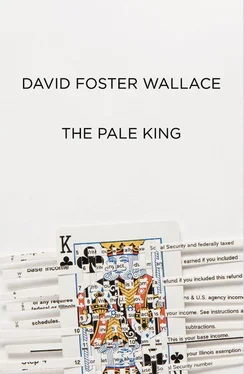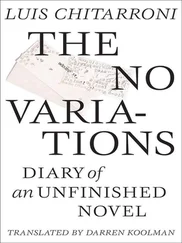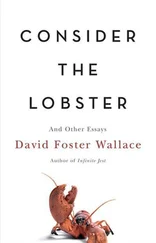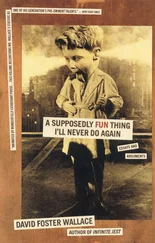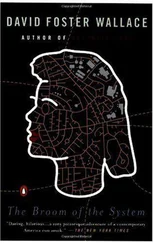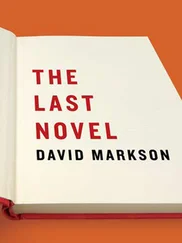David Wallace - The Pale King - An Unfinished Novel
Здесь есть возможность читать онлайн «David Wallace - The Pale King - An Unfinished Novel» весь текст электронной книги совершенно бесплатно (целиком полную версию без сокращений). В некоторых случаях можно слушать аудио, скачать через торрент в формате fb2 и присутствует краткое содержание. Год выпуска: 2011, Издательство: Little, Brown & Company, Жанр: Современная проза, на английском языке. Описание произведения, (предисловие) а так же отзывы посетителей доступны на портале библиотеки ЛибКат.
- Название:The Pale King: An Unfinished Novel
- Автор:
- Издательство:Little, Brown & Company
- Жанр:
- Год:2011
- ISBN:нет данных
- Рейтинг книги:3 / 5. Голосов: 1
-
Избранное:Добавить в избранное
- Отзывы:
-
Ваша оценка:
- 60
- 1
- 2
- 3
- 4
- 5
The Pale King: An Unfinished Novel: краткое содержание, описание и аннотация
Предлагаем к чтению аннотацию, описание, краткое содержание или предисловие (зависит от того, что написал сам автор книги «The Pale King: An Unfinished Novel»). Если вы не нашли необходимую информацию о книге — напишите в комментариях, мы постараемся отыскать её.
The Pale King
The Pale King: An Unfinished Novel — читать онлайн бесплатно полную книгу (весь текст) целиком
Ниже представлен текст книги, разбитый по страницам. Система сохранения места последней прочитанной страницы, позволяет с удобством читать онлайн бесплатно книгу «The Pale King: An Unfinished Novel», без необходимости каждый раз заново искать на чём Вы остановились. Поставьте закладку, и сможете в любой момент перейти на страницу, на которой закончили чтение.
Интервал:
Закладка:
Overall, despite comprising scarcely more than 5,750 total words, the initial recruiting presentation and processing lasted almost three hours, during which there were also several intervals when the recruiter trailed off and sat in a heavy, incongruous silence during which he may or may not have been asleep — the sunglasses made it impossible to verify. (I would later be informed that these unexplained pauses, too, were part of initial recruit screening and ‘dispositional assessment,’ that the shabby recruiting office was, in fact, under sophisticated videotape surveillance — one of the required forms had contained an ‘Authorization to Record’ buried in one of the subclause’s boilerplate, which I obviously did not notice at the time — and that our fidget- and yawn-rates and certain characteristics of posture, position, and facial expression in certain contexts would be reviewed and compared to various psychological templates and predictive formulas which the Service’s Internal Control Branch’s Personnel Division’s Recruitment and Training subdivision had developed several years prior, which is, in turn, a very long and complicated story involving the Service’s emphasis, throughout the 1960s and ’70s, on maximizing ‘throughput,’ meaning the highest possible efficiency in terms of the volume of tax returns and documents that could be processed, examined, audited, and adjusted in a given fiscal quarter. Though the Service’s concept of efficiency would undergo changes in the 1980s, as new government priorities trickled down through the Treasury and Triple-Six, with an institutional emphasis on maximizing revenue rather than throughput of returns, the emphasis at the time — meaning January 1979—required screening recruits for a set of characteristics that boiled down to an ability to maintain concentration under conditions of extreme tedium, complication, confusion, and absence of comprehensive info. The Service was, in the words of one of the Examinations instructors at the Indianapolis TAC, looking for ‘cogs, not spark plugs.’
Eventually, it was beginning to get dark and to snow again by the time the recruiter announced that the process was over, and we — by this time there were perhaps five or six of us in the audience, some having drifted in during the formal presentation — were then each given a ream-sized stack of stapled packets of materials in a large blue IRS binder. The recruiter’s final instructions were that those of us who felt we were still potentially interested should go home and read these materials closely, and return the next day — which would, if I remember right, have been a Friday — for the next stage of the recruitment process.
To be honest, I had expected to be interviewed and asked all sorts of questions about my background, experience, and direction in terms of career and commitment. I expected that they would want to verify I was serious and not just there to scam the IRS out of free tuition funding. Not surprisingly, I had expected that the Internal Revenue Service — which my father, whose job with the city had understandably involved dealings with the IRS on a variety of levels, feared and respected — would be acutely sensitive to the possibility of being scammed or conned in any way, and I remember, on the long trek in from the bus stop, that I had been apprehensive about what to say in response to tough questioning about the origin of my interest and goals. I’d been concerned about how to tell the truth without the Service’s recruiters reacting the way the Associate Dean for Academic Affairs had just recently reacted, or thinking of me in anything like the way I had thought about the Christian girl with the multifloral boots in the Lindenhurst memory already mentioned. To the best of my recollection, though, I was required to say almost nothing that first day of recruiting after the initial hello and one or two innocuous questions — as well as my name, of course. Nearly all my input was, as I’ve mentioned, in the form of forms, many of which had bar codes in the lower left corners — this detail I remember because these were the first bar codes I can remember ever being aware of in my life up to then.
Anyhow, the recruiting office’s binder full of homework was so unbelievably dry and obscure that you essentially had to read each line several times to derive any sense of what it was trying to say. I almost couldn’t believe it. I had already gotten a taste of real accounting language from the assigned textbooks for Managerial Accounting and Auditing I, which were both just under way — when weather permitted — at DePaul, but the Service material made those textbooks look like child’s play by comparison. The largest single packet in the binder was something on low-toner Xerox called Statement of Procedural Rules, which is actually from Title 26, § 601 of the Code of Federal Regulations. A ninety-five-word section of a page that I remember that I flipped to at first at random and read, just to get an idea of what I would be having to try to read and process, was ¶1910, § 601.201a(1)(g), subpart xi:
For ruling requests concerning the classification of an organization as a limited partnership where a corporation is the sole general partner, see Rev. Proc. 72–13, 1972–1 CB 735. See also Rev. Proc. 74–17, 1974–1 CB 438, and Rev. Proc. 75–16, 1975–1 CB 676. Revenue Procedure 74–17 announces certain operating rules of the Service relating to the issuance of advance ruling letters concerning the classification of organizations formed as limited partnerships. Revenue Procedure 75–16 sets forth a checklist outlining required information frequently omitted from requests for rulings relating to classification of organizations for Federal tax purposes.
Essentially, the whole thing was like that. Nor, at the time, did I know we would have to try to practically memorize the entire 82,617-word Procedural Rules manual at the Training and Assessment Center, less for informational purposes — since every IRS examiner’s Tingle table would have the Procedural Rules included in the Internal Revenue Manual right there in the bottom-right drawer, attached with a little chain so no one could take or borrow it, as we were all supposed to have it at our Tingle at all times — but more as a type of diagnostic tool for seeing who could sit there hour after hour and apply themselves to it versus who couldn’t, which obviously bore on who could cut it at various levels of complexity and dryness (which, in turn, is why the Examinations component of the TAC’s training course was known at the TAC as ‘Camp Concentration’ ). My best guess at the time, sitting there in my childhood room in my father’s house in Libertyville (the dorm at DePaul still wasn’t open, as some frozen pipes had ruptured — the storm and its fallout still had much of the city paralyzed), was that requiring us to read this material was some kind of test or hurdle to help determine who was truly motivated and serious and who was just drifting around attempting to scam some easy tuition money from the government. I kept picturing the indigent character who ate all the doughnuts from that afternoon’s presentation lying in a cardboard appliance box in an alley, reading a page of the packet and then setting it afire to provide light for reading the next page. In a certain way, I think that that was essentially what I was doing, too — I had to blow off nearly all my next day’s accounting class assignments in order to stay up nearly all night getting through the Service material. It didn’t feel feckless, though it also didn’t feel especially romantic or heroic. It was more as if I simply had to make a choice of what was more important.
I read more or less the whole thing. I won’t even say how many words in toto. It took until almost 5:00 A.M. At the very back — not all the way, but tucked between two pages of the transcript of a 1966 USTC case called Uinta Livestock Corporation v. U.S. near the back of the binder — were a couple of more forms to fill out, which reinforced my assumption that it really had been a kind of test to see if we were committed and interested enough to nut up and plow all the way through. I can’t say I read everything carefully, of course. One of the few packets that wasn’t totally eye-glazing was a rundown on the IRS Training and Assessment Centers and on the various types of entry-level posts available to recruits who came out of the TAC course with various levels of education and incentive packages. There were two IRS Training and Assessment Centers, in Indianapolis and Columbus OH, about which the packet had photos and regulations but nothing specific on what the training was actually like. As usually happens with photocopied photos, the images were mostly black masses with some indistinct white blobs; you couldn’t really make out what was going on. Unlike the present day, the protocol in that era was that if you wanted a serious career in the Service, with a contract and civil service rank above GS-9, you had to go through a TAC course, which lasted twelve weeks. You also had to join the Treasury Employees union, although info on that criterion was not included in the packet. Otherwise you were, in essence, a temporary or seasonal worker, which the Service uses a lot of, especially in the lower levels of Returns Processing and Exams. I remember that the Post List’s representation of the Service’s structure was much simpler and less comprehensive than the recruiter’s presentation’s diagram, although this one also had a lot of asterisks and single and double lines connecting various parts of the page’s grid, and the legend for these marks had been half cut off due to someone having xeroxed the thing at an angle. In that era, the six main nodes or Service branches consisted of Administration, Returns Processing, Compliance, Collections, Internal Control, Support Services, and something called Technical Branch, which was the only branch with the actual word Branch in its name on the diagram, which at the time I found curious. Each branch then branched into several subordinate divisions — thirty-six divisions in all, though in today’s Service there are now forty-eight separate divisions, some with cross-coordinated and overlapping functions which have to be streamlined and overseen by the Divisional Liaison Division, which is itself — somewhat confusingly — a division of both the Administration and Internal Control Branches. Each division then also comprised numerous subdivisions, some of whose typeface got extremely small and hard to read. The Compliance Branch’s Examinations Division, for example, comprised positions — though only those postings marked in italic font (which was practically impossible to make out on the Xerox) required a federal contract or TAC course — in clerical, cart, data entry, data processing, classification, correspondence, district office interface, regional office interface, duplicating services, procurement, research audit interface, secretarial, personnel, service center interface, computer center interface, and so forth, as well as formal ‘rote examiner’ posts grouped (in that era, though here at the Midwest REC now the group characterizations are quite a bit different) by the types of returns one specialized in, encoded on the diagram as 1040, 1040A, 1041, EST, and ‘Fats,’ which refers to a complex 1040 with more than four schedules or attachments. Also, corporate 1120 and 1120S tax returns are examined by special examiners known in Exams as ‘immersives,’ which the recruiting page did not include information on, as immersive exams are conducted by special elite, highly trained examiners who have their own special section of the REC facility.
Читать дальшеИнтервал:
Закладка:
Похожие книги на «The Pale King: An Unfinished Novel»
Представляем Вашему вниманию похожие книги на «The Pale King: An Unfinished Novel» списком для выбора. Мы отобрали схожую по названию и смыслу литературу в надежде предоставить читателям больше вариантов отыскать новые, интересные, ещё непрочитанные произведения.
Обсуждение, отзывы о книге «The Pale King: An Unfinished Novel» и просто собственные мнения читателей. Оставьте ваши комментарии, напишите, что Вы думаете о произведении, его смысле или главных героях. Укажите что конкретно понравилось, а что нет, и почему Вы так считаете.
